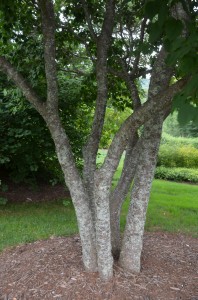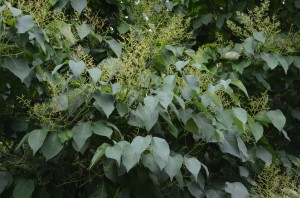Japanese tree lilac (Syringa reticulata) is a late flowering lilac, often 2-3 weeks later than the popular common and hybrid shrub lilacs (USDA hardiness zone 3-7). Tree lilac is tall growing, often 20-25 feet tall with a 15-25 foot spread. It forms a nice small multi-trunked street tree.
Tree lilac is the last of the lilacs to bloom. In the Southern Appalachian region (USDA hardiness zones 6 and 7) it blooms in late May and later further north. Large 6 to 12 inch long clusters of creamy white flowers form on the terminal branches and are both showy and fragrant. Two popular cultivars are Ivory Silk® and ‘Summer Sun’. Ivory Silk was chosen as a 1996 Gold Medal Plant by the Pennsylvania Horticultural Society.
Its form and flowering makes it a great choice around a deck or patio as an accent plant. Dark reddish brown bark is white speckled and becomes quite showy when wet following a summer shower. Fall leaf color is usually a non-event.
Tree lilac favors a northerly climate. Fall leaf colors are better in the northern part of its range. Good air circulation is important to prevent leaf diseases that plague other Syringa species. Lilac borers may be problematic if weather is extremely hot and dry. It needs a few hours of afternoon shade in the mid-South.
As with most spring flowering shrubs, prune within a month after flowering. Tree lilac tends to bloom heavier one year and lighter the following year. Removal of seed heads tends to promote annual blooming. Annual pruning controls plant height and shape.



 Posted in
Posted in 
